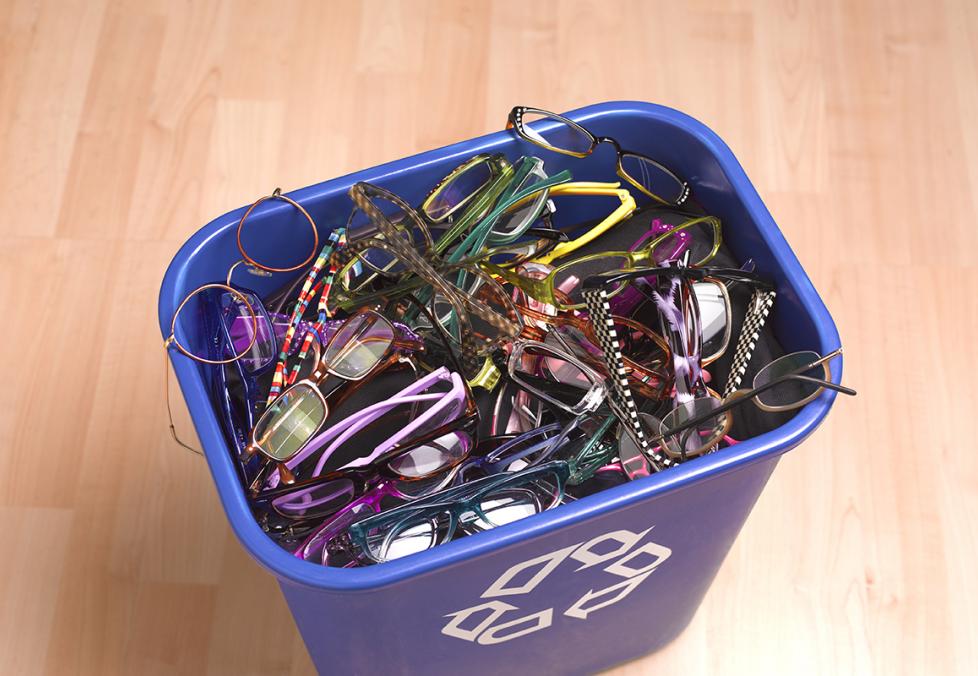
Today, what's good for your eyes is also good for the planet. Discover the frames, contacts, and practices that are lowering our environmental impact.
Everything you need to know to take care of your eyes — for life.
You recycle, use canvas bags, and may even compost — but did you know that there are environmentally friendly ways to dispose of your eyeglasses and contact lenses?

From canvas grocery bags to bamboo straws, there are eco-friendly alternatives to plastic everywhere. But if you’re having trouble seeing, you’ll probably need to choose plastic.
Both eyeglasses and contact lenses are made of plastic — and so are the eyewear cases, cleaning solution bottles, and even the ink on the packaging.
That’s not always a bad thing, says Jennifer Palombi, O.D. She’s a contact lens specialist and spokesperson for CooperVision, a global leader in contact lenses, including Sofmed, with the widest range of prescription options.
“The reason everything is packaged in plastic, particularly for contacts, is because it keeps the lenses sterile and safe to wear,” Dr. Palombi says. “Plastic is wonderful for what it’s intended to do, which is to be durable and keep things sterile. We just have to be responsible with how we dispose of it after it’s used.”
Luckily, there are ways to do just that. Here’s how to make your eye care routine more environmentally friendly.
Contact lenses — including the “blister” packaging they come in — are often too small for the recycling plant’s machinery to pick up. And even though the plastic from the contacts makes up only a tiny percentage of all household waste, says Dr. Palombi, it’s a good idea to offset as much of that plastic as possible.
To that end, some contact lens manufacturers, including CooperVision, have committed to a process called “net plastic neutrality.”
Here’s how it works: When you buy a box of Clariti® or MyDay® contact lenses, CooperVision promises to make sure the same amount of plastic, in weight, is collected from the environment before it reaches the ocean.
CooperVision works with Plastic Bank, a plastic collection organization that builds ethical recycling ecosystems in underserved coastal communities in Indonesia, the Philippines, Brazil, and Egypt.
“With Clariti and MyDay, we’re picking up an equal amount of plastic back out of the environment,” says Dr. Palombi. She adds, “There’s a social good to it as well. The people out there collecting for Plastic Bank are getting the essentials they need for their day-to-day life too.”
Did you know that contact lens prescriptions need to be renewed every year? Find an exam time that fits your schedule.
Even if you don’t recycle your lenses, at least throw them away in a wastebasket. About 1 in 5 people dispose of their contact lenses by flushing them down the toilet or bathroom sink, according to some research.
The problem is, “lenses that go down the drain or toilet end up in water treatment plants, where they can be broken down into microplastics that go into the water,” says Dr. Palombi.
Scientists don’t yet fully understand how harmful microplastics — plastic debris that’s less than 5 millimeters long — may be to the environment. But some experts believe they pose a risk to marine life. And the less plastic we have in our water, the better.
Need a new glasses prescription? Don’t toss your frames (or leave them sitting in your closet forever). Instead, try giving them to an organization such as Lions Clubs International or ReSpectacle, which collects old eyeglasses and donates them to people in need.
If you wear contact lenses, it’s good to know that the type of contact lens you choose — dailies vs. extended wear lenses, for example — won’t have much of an environmental impact, if any, says Dr. Palombi.
While you may throw away more plastic lenses if you use dailies, you won’t have to buy replacement cases or bottles of solution regularly, so you’re using almost the same amount of plastic, she says.
It’s also good to know that the contact lenses packaging (not the lenses themselves) can often be recycled, Dr. Palombi adds. For example, some eye doctors’ offices have recycling bins that can take the foils and blister packaging the lenses come in.
If you’re trying to recycle your contact lenses packaging at home, check your local recycling ordinance to see what you can toss in your curbside bins. Sometimes the blister packaging is too small to get picked up by the recycling plant’s machinery, she says, so you don’t want to toss them in with other recyclables without checking first.

Today, what's good for your eyes is also good for the planet. Discover the frames, contacts, and practices that are lowering our environmental impact.
“Recycled eyeglasses” doesn’t have to mean “secondhand eyeglasses.”
In fact, many of the latest — and trendiest — eyewear frames are now being made from recycled materials such as plastic and abandoned fishing nets that are found near the ocean.
“There are doctors that lean toward populating their optical shops with frames that are made from recycled materials or made in an eco-friendly way,” says Dr. Palombi.
Fashionable and sustainable? That’s something that never goes out of style.